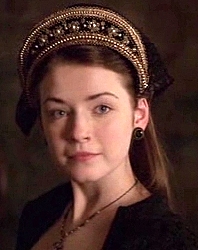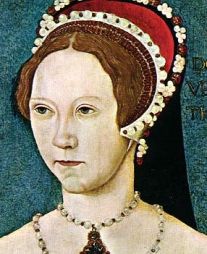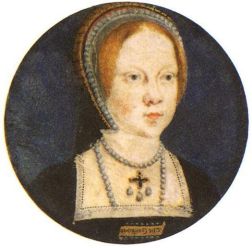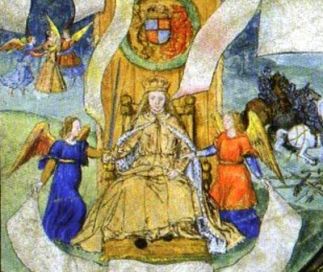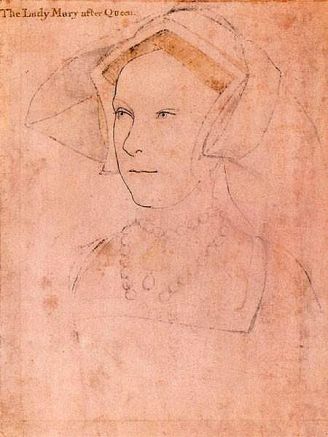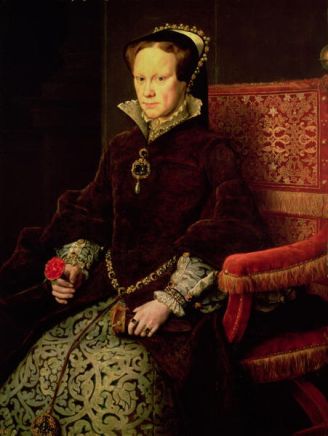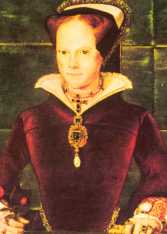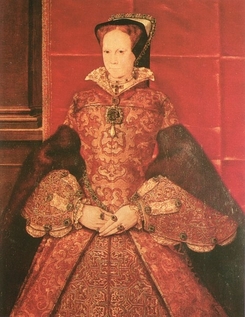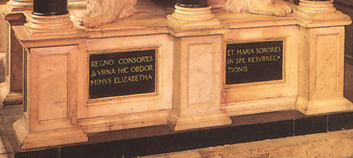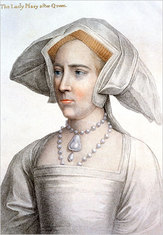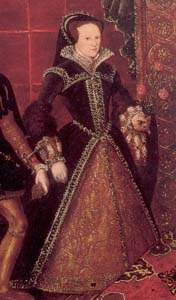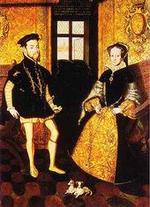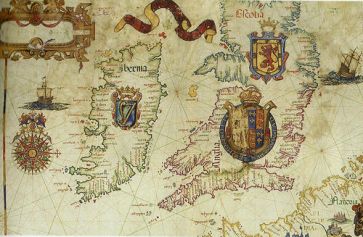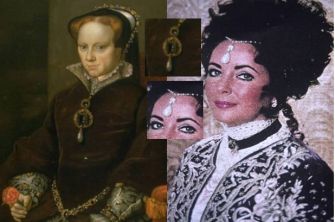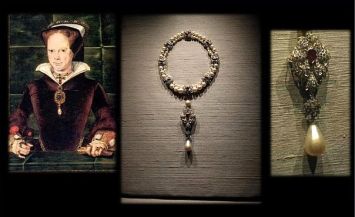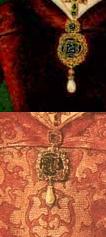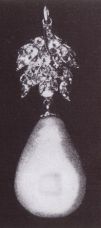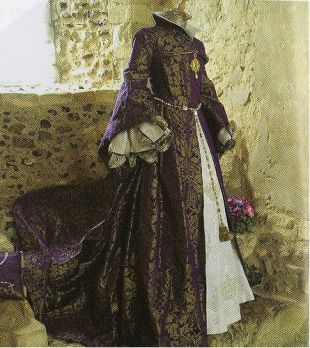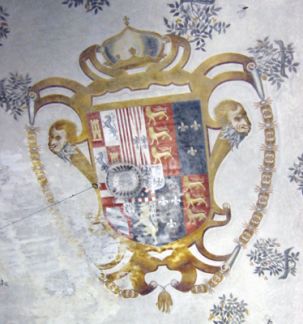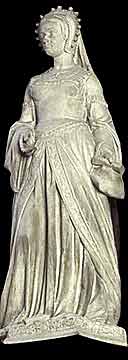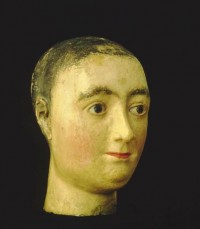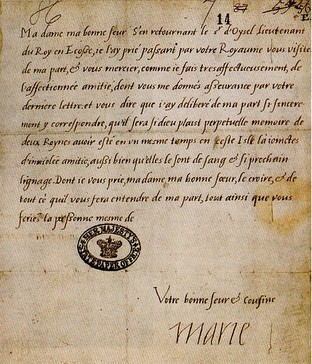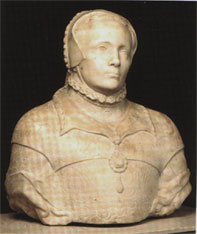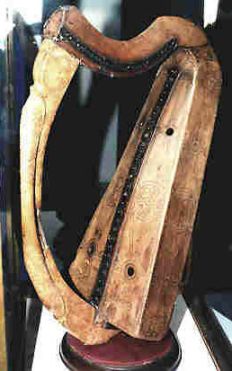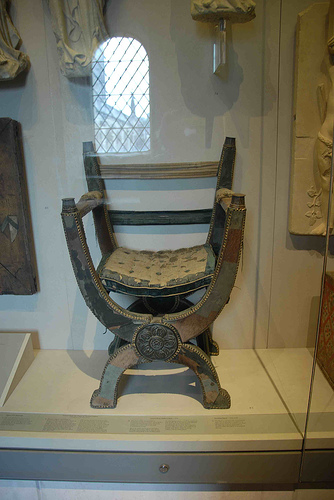Queen Mary I - Historical profile
Jump to navigation
Jump to search
Click here: Queen Mary I historical profile continued - Page 2
| The History of Queen of England & Ireland From July 19, 1553 (aged 37) till her death in November 17, 1558 (4 1/2 yrs) Want to add to this page? Click EasyEdit to update this page! (Don't see the EasyEdit button above? <a href="/#signin" target="_self">Sign in</a> or <a href="/accountnew" target="_self">Sign up</a>.) |
| INTERESTING FACTS: - She was an accomplished & talented musician excelled at the spinet and virginals,like her father Henry,also Mary taught Elizabeth how to play the lute and virginals. - Mary was given the best tutors and studied the works of leading scholars: Linacre, William Lily, Sir Thomas More, Erasmus of Rotterdam, and the Spanish humanist, Vives. She spoke Latin, French, Spanish and understood Italian. She learned the basic skills of riding side-saddle, sewing and embroidery - During Mary's childhood, various husbands were proposed for her, including the eldest son of Francis I of France (1518), the Holy Roman Emperor Charles V (1522), Francis I himself (1527) and even her father's illegitimate son, Henry Fitzroy which was strangely sanctioned by the Pope. Princess Mary Tudor, when she was eight - In 1525 she was given a separate household as the Princess of Wales, but in 1527, Henry began negotiations for a divorce from her mother Queen Katherine of Aragon, and Mary, remaining loyal to her mother and to the Roman Catholic Church, spent the next nine years in misery -She was separated from Katharine, denied presence at court, declared illegitimate, and forced to serve her half sister Elizabeth I as lady in waiting. - Plans to escape to the Continent failed, and in 1536, Mary was finally forced to acknowledge herself as illegitimate and to repudiate her church, statements from which she was later absolved by the pope. - She did not approve of Henry's 4th wife Katherine Howard, who was 9 years younger than herself. And Katherine complained that Mary did not pay her the respect she had bestowed on Henry's previous queens, Jane Seymour and Anne of Cleves, and, to assert her status, ordered the dismissal of two of Mary's maids. Mary reportedly took Katherine Howard's demise in stride while her younger half-sister, 9 year old Princess Elizabeth Tudor, was profoundly affected. & swore she would never marry -- a vow she would not break. - She was never close to her half-brother Prince Edward Tudor after he became King, who was a devout Protestant and was dominated by John Dudley and the Seymour brothers. - -Mary in a letter to Thomas Cromwell, Earl of Essex in 1536: "I perceived that nobody durst speak for me as long as that woman lived, which is now gone(referring to queen Anne) whom I pray to our Lord, of his great mercy to forgive" - In Spring 1547, after Henry's death, the Queen Dowager, Catherine Parr, married Lord Thomas Seymour, Lord High Admiral and uncle to the king. Mary was personally offended as her father had only died in January. Seymour also wrote her a letter asking for support of the marriage; of course she refused. Mary had left the Dowager Queen's household after her father left her a large inheritance which included the lands of the Duke of Norfolk. She asked her half-sister Elizabeth to join her as Mary didn't approve of Seymour. Mary eventually got over the marriage and reconciled with the Dowager Queen. When the Dowager Queen gave birth to a baby girl, she was named after Lady Mary. -Queen Mary was repeatedly urged to rid herself of Lady Jane, but declined, as she pitied the little usurper (Jane was her cousin), declaring that she was more the pawn of others then an instrument in herself. -Mary was the first genuine queen regnant of England. (If one discounts the 9 day queen, Lady Jane Grey, who was not crowned.) - Mary objected to being anointed with the same consecration oils used in her brother’s coronation, arguing that they had been tainted by their use in a Protestant ceremony. Thus she wrote to the bishop of Arras in Brussels for a new ‘uncontaminated’ supply of holy oil. She did not refuse to sit on the same throne as Edward as some have stated. -Mary was the first English queen to claim that she would not marry. Although in the end she did. - On 25 July 1554 she married her cousin, Philip II of Spain. Mary was 11 years older than Philip. It worried her that he was so much younger because he was "likely to be disposed to be amorous, and such is not my desire, not at my time of life, and never having harbored thoughts of love." With difficulty the Emperor's envoy convinced her that Philip was a stable, mature adult who would help protect her kingdom. - The English Parliament refused to crown him jointly with Mary, so he had little power in England & he left England within the year. Shortly after their marriage Mary announced she was pregnant, but it was a phantom pregnancy. - The tiniest dwarf in Royal service was Queen Mary's two foot Page of Honour, John Jarvis. - Mary had poor eyesight, had regular headaches, frequent depressive episodes, anxiety and more health issues which impacted her greatly (most likely due to her chaotic life). - The number of protestants burned at the stake amounted almost to 300, and included such eminent figures as Nicholas Ridley, John Rogers, Hugh Latimer, and Thomas Cranmer - The nickname "Bloody Mary" was a result of these acts, though they were less severe than many other monarchs on the strife-torn European continent including her father King Henry VIII, Edward VI, and Queen Elizabeth I. -Mary was very caring to her less fortunate subjects. She would go to the poorer districts and give alms directly to the people, sometimes dressing in the same cloth as her ladies -Mary placed her sister Princess Elizabeth Tudor in the Tower after she learned of a Protestant plot to overthrow her in her sister's name, and Elizabeth reasonably feared for her life. However, it is interesting to note that her husband Phillip of Spain may have had a hand in lessening Mary I's anger towards Elizabeth during her time in the Tower. This was because he saw Elizabeth as a potential wife in the event of Mary's death.
|
 Giovanni Michieli was the Venetian Ambassador to Mary's court. He produced the following detailed description of the Queen. Toward the end, he mentions Mary's infamous menstrual problems, the cause of great physical and psychological stress for the Queen : Giovanni Michieli was the Venetian Ambassador to Mary's court. He produced the following detailed description of the Queen. Toward the end, he mentions Mary's infamous menstrual problems, the cause of great physical and psychological stress for the Queen : "She is of low rather than of middling stature, but, although short, she has not personal defect in her limbs, nor is any part of her body deformed. She is of spare and delicate frame, quite unlike her father, who was tall and stout; nor does she resemble her mother, who, if not tall, was nevertheless bulky. Her face is well formed, as shown by her features and lineaments, and as seen by her portraits. When younger she was considered, not merely tolerably handsome, but of beauty exceeding mediocrity. At present, with the exception of some wrinkles, caused more by anxieties than by age, which makes her appear some years older, her aspect, for the rest, is very grave. Her eyes are so piercing that they inspire not only respect, but fear in those on whom she fixes them, although she is very shortsighted, being unable to read or do anything else unless she has her sigh quite close to what she wishes to peruse or to see distinctly. Her voice is rough and loud, almost like a man's, so that when she peaks she is always heard a long way off. In short, she is a seemly woman, and never to be loathed for ugliness, even at her present age, without considering her degree of queen. But whatever may be the amount deducted from her physical endowments, as much more may with truth, and without flattery, be added to those of her mind, as, besides the facility and quickness of her understanding, which comprehends whatever is intelligible to others, even to those who are not of her own sex (a marvellous gift for a woman), she is skilled in five languages, not merely understanding, but speaking four of them fluently - English, Latin, French, Spanish, and Italian, in which last, however, she does not venture to converse, although it is well known to her; but the replies she gives in Latin, and her very intelligent remarks made in that tongue surprise everybody.... Besides woman's work, such as embroidery of every sort with the needle, she also practices music, playing especially on the clavichord and on the lute so excellently that, when intent on it...she surprised the best performers, both by the rapidity of her hand and by her style of playing. Such are her virtues and external accomplishments. Internally, with the exception of certain trifles, in which, to say the truth, she is like other women, being sudden and passionate, and close and miserly, rather more so than would become a bountiful and generous queen, she in other respects has no notable imperfections; whilst in certain things she is singular and without an equal, for not only is she brave and valiant, unlike other timid and spiritless women, but she courageous and resolute that neither in adversity nor peril did she ever even display or commit any act of cowardi ce or pusillanimity, maintaining always, on the contrary, a wonderful grandeur and dignity, knowing what became the dignity of a sovereign as well as any of the most consummate statesmen in her service; so that from her way of proceeding and from the method observed by her (and in which she still perseveres), it cannot be denied that she shows herself to have been born of truly royal lineage. [She is also subject to] a very deep melancholy, much greater than that to which she is constitutionally liable, from menstrous retention and suffocation of the matrix to which, for many years, she has been often subject, so that the remedy of tears and weeping, to which from childhood she has been accustomed, and still often used by her, is not sufficient; she requires to be blooded either from the foot or elsewhere, which keeps her always pale and emaciated." | |||
| POSITIVE ASPECTS OF MARY I'S REIGN: -she successfully protected the northern borders - she oversaw the formation of the Muscovy Company in 1555, therefore opening trade links between England and the Baltics and Russia (which in turn alleviated dependence on Calais). -she successfully rallied support against Wyatt’s rebellion in 1554 contributing to the failure of that uprising and she successfully defended her throne from later potential threats. -her council took serious actions in regards to the forging of foreign and domestic coinage, therefore attempting to appease the dire economic situation she had inherited. -she also frequently appointed men based on their expertise, even those who had served under her brother and oversaw the earlier policies she detested. -she was also capable of taking sound advice from her husband, who she granted permission to reform the state of the English navy (and under her numerous ships were repaired and built after being left in poor states under Edward VI). Elizabeth I certainly found that handy later on! -so she did do some good with her power. And she took her role serious and did not mind having to deal with lots of paperwork. Certainly she had more patience than her father! Whilst the religious persecutions are a significant part of her reign and cannot be overlooked,they shouldn't be used as the definitive aspect and indicate that her whole reign was a failure. [SOURCE : littlemisssunnydale - IMDB] Lovers of literature and music have much to be grateful for from the reign of Queen Mary I. William Roper, son-in-law of Thomas More, at last felt that the time was right to complete his life of his father-in-law, essentially a draft version later expanded by Nicholas Harpsfield. | 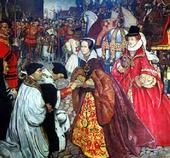 Mary I, on her coronation day, swearing on the bible to uphold the Law. [modern illustration] Mary I, on her coronation day, swearing on the bible to uphold the Law. [modern illustration]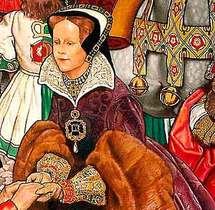 Mary receives the bishop's hands, symbolizing an alliance to her faith. Mary receives the bishop's hands, symbolizing an alliance to her faith. When she came to the throne, she reinstated England's former ties to the Catholic Church, and burned and persecuted 284 Protestants, while approximately 800 fled to the continent in exile. Three of the most famous victims of the Marian persecutions were Archbishop Thomas Cranmer, Hugh Latimer, and Nicolas Ridley. Although her reign was no bloodier than her father's, or her Protestant half-siblings, she came to be known as "Bloody Mary." Her marriage to Philip II of Spain was unpopular, because he was a foreigner. The English people started hating her. She died without an heir and without the popularity and renown her sister, Elizabeth I was to enjoy. | |||
| Plaque by the tomb (built by James I) of Mary and Elizabeth in Westminster. It reads: "Partners both in throne and grave, here rests we two sisters, Elizabeth and Mary, in hope of one Resurrection" Elizabeth gave Mary a royal funeral and interred her in the chapel their grandfather Henry VII had built in the Abby, where they are now buried together. | ||||
| <a class="external" href="http://englishhistory.net/tudor/primary1.html" rel="nofollow" target="_blank">Letter dated June 22, 1536 </a> <a class="external" href="http://englishhistory.net/tudor/primary1.html" rel="nofollow" target="_blank">in which Mary writes to her father, the King, accepting the annulment of her parents' marriage, her illegitimacy, and the supremacy of the English church</a> Mary had avoided writing the letter during her father's marriage to Anne Boleyn. After Anne's execution and her mother's death, Mary finally wrote it and was able to return to court and her father's good graces, but regretted her action ever after. 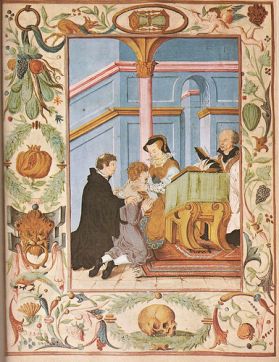 Mary I touching a sufferer of scrofula (known as the ‘King’s evil’). It was believed in some parts of Europe that the royal touch was divine and held the power to cure ailments. Under Edward VI the tradition had been abandoned and some Protestants deemed the traditional as superstitious (although the practice was carried out in different forms under several Protestant monarchs including Charles I). Under Mary, the practice was revived. The illustration dates from Mary’s reign. | LITERATURE: Non-fiction:
| |||
| King Philip II of Spain, he grew tired of Mary as she always refused to grant him ownership of what she considered to be her crown, he left England after no more than a year. A page from the Queen Mary Atlas. It was commissioned by Mary for her husband by the Portuguese cartographer, Diego Homem. The atlas was supposed to highlight the alliance between England and Spain and the arms of both were depicted. However during the reign of Elizabeth I, Philip’s arms were partially removed (note the big arms in the middle of page and how the left half has been scratched out. This depicted Philip’s royal arms). La Peregrina pearl. It was discovered in Panama in the mid-sixteenth century and was either purchased or given to Philip of Spain who in turn presented it to his second wife, Mary Tudor. Throughout the subsequent centuries, the pearl was placed on different items and came into the ownership of numerous European families. In 1969 actor Richard Burton purchased the pearl for $37,000 for his then wife, Elizabeth Taylor. He had Cartier reset the pearl on a necklace with other precious items (diamonds, rubies and pearls). The necklace is still owned by Taylor and is depicted in this image. La Pelegrina a teardrop pearl worn by Mary I. Mary often had it attached to the bottom of her brooches. The pearl currently is owned by Elizabeth Taylor. Click Link for more : <a class="external" href="http://home.earthlink.net/~elisale/lapelegrina.html" rel="nofollow" target="_blank" title="About Le Pelegrina">About Le Pelegrina</a> | Replica of queen Mary's wedding dress PHILLIP II OF SPAIN 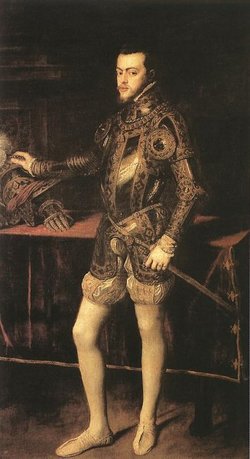 "Throughout his long life, he made himself a martyr to what he conceived to be his duty; a slow, laborious, unimaginative, morbidly conscientious Man, a good son, a good father; kind and indulgent to his servants, patient under adversity, and humble in success; indeed a man endowed with most of the elements of righteousness, and with a sense of right so blunted by his zeal as to to think that he might do God's work with the weapons of the devil and turn enemies into friends by fear". [ Martin Hume "Two English Queens and Philip] 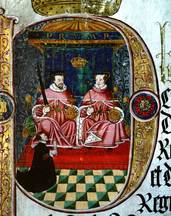 On his way to his marriage, he said "I am going to a crusade, not to a marriage feast". He was fueled by a religious desire to father a Catholic heir who would keep England within the Roman Catholic sphere and in fact when Mary died, he proposed marriage to her sister Elizabeth in an effort to keep England in his grasp. On his way to his marriage, he said "I am going to a crusade, not to a marriage feast". He was fueled by a religious desire to father a Catholic heir who would keep England within the Roman Catholic sphere and in fact when Mary died, he proposed marriage to her sister Elizabeth in an effort to keep England in his grasp. | |||
| Statue of Mary I, located in The House of Lords | Funeral effigy of Mary, now displayed in the museum of Westminster Abbey | |||
| letter from Mary Stuart to her cousin Queen Mary Tudor | Bust of Queen Mary I | |||
| Queen Mary's harp. Like her father Henry and sister Elizabeth,Mary was talented musician. |
Click here: Queen Mary I historical profile continued - Page 2
